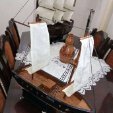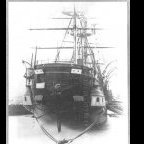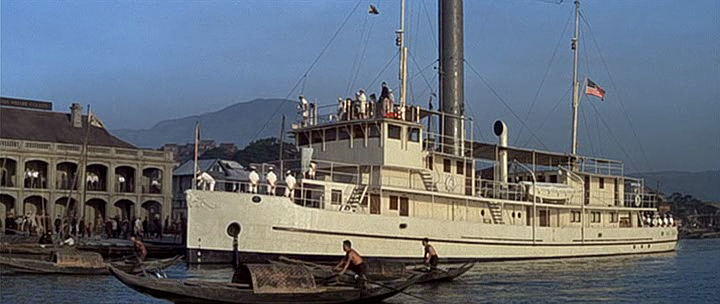-
Posts
661 -
Joined
-
Last visited
About Ras Ambrioso

- Birthday 11/03/1936
Profile Information
-
Gender
Male
-
Location
Bradenton Florida USA
-
Interests
Model building, gun collector, target shoooting
Recent Profile Visitors
-
 Ras Ambrioso reacted to a post in a topic:
Pomeranian Rahschlup 1846 by wefalck – 1/160 scale – single-masted Baltic trading vessel
Ras Ambrioso reacted to a post in a topic:
Pomeranian Rahschlup 1846 by wefalck – 1/160 scale – single-masted Baltic trading vessel
-
 Ras Ambrioso reacted to a post in a topic:
USS Cape (MSI-2) by Dr PR - 1:48 - Inshore Minesweeper
Ras Ambrioso reacted to a post in a topic:
USS Cape (MSI-2) by Dr PR - 1:48 - Inshore Minesweeper
-
 Ras Ambrioso reacted to a post in a topic:
USS Cape (MSI-2) by Dr PR - 1:48 - Inshore Minesweeper
Ras Ambrioso reacted to a post in a topic:
USS Cape (MSI-2) by Dr PR - 1:48 - Inshore Minesweeper
-
 Ras Ambrioso reacted to a post in a topic:
USS Cape (MSI-2) by Dr PR - 1:48 - Inshore Minesweeper
Ras Ambrioso reacted to a post in a topic:
USS Cape (MSI-2) by Dr PR - 1:48 - Inshore Minesweeper
-
 Ras Ambrioso reacted to a post in a topic:
USS Cape (MSI-2) by Dr PR - 1:48 - Inshore Minesweeper
Ras Ambrioso reacted to a post in a topic:
USS Cape (MSI-2) by Dr PR - 1:48 - Inshore Minesweeper
-
 Ras Ambrioso reacted to a post in a topic:
USS Cape (MSI-2) by Dr PR - 1:48 - Inshore Minesweeper
Ras Ambrioso reacted to a post in a topic:
USS Cape (MSI-2) by Dr PR - 1:48 - Inshore Minesweeper
-
 Ras Ambrioso reacted to a post in a topic:
USS Cape (MSI-2) by Dr PR - 1:48 - Inshore Minesweeper
Ras Ambrioso reacted to a post in a topic:
USS Cape (MSI-2) by Dr PR - 1:48 - Inshore Minesweeper
-
 Ras Ambrioso reacted to a post in a topic:
USS Cape (MSI-2) by Dr PR - 1:48 - Inshore Minesweeper
Ras Ambrioso reacted to a post in a topic:
USS Cape (MSI-2) by Dr PR - 1:48 - Inshore Minesweeper
-
 Ras Ambrioso reacted to a post in a topic:
Pomeranian Rahschlup 1846 by wefalck – 1/160 scale – single-masted Baltic trading vessel
Ras Ambrioso reacted to a post in a topic:
Pomeranian Rahschlup 1846 by wefalck – 1/160 scale – single-masted Baltic trading vessel
-
 Ras Ambrioso reacted to a post in a topic:
USS Cape (MSI-2) by Dr PR - 1:48 - Inshore Minesweeper
Ras Ambrioso reacted to a post in a topic:
USS Cape (MSI-2) by Dr PR - 1:48 - Inshore Minesweeper
-
 popeye the sailor reacted to a post in a topic:
The M&M Fun Ship by popeye the sailor - FINISHED - 1:33 scale - the lost log
popeye the sailor reacted to a post in a topic:
The M&M Fun Ship by popeye the sailor - FINISHED - 1:33 scale - the lost log
-
 FriedClams reacted to a post in a topic:
USS Cape (MSI-2) by Dr PR - 1:48 - Inshore Minesweeper
FriedClams reacted to a post in a topic:
USS Cape (MSI-2) by Dr PR - 1:48 - Inshore Minesweeper
-
 Canute reacted to a post in a topic:
USS Cape (MSI-2) by Dr PR - 1:48 - Inshore Minesweeper
Canute reacted to a post in a topic:
USS Cape (MSI-2) by Dr PR - 1:48 - Inshore Minesweeper
-
 Nirvana reacted to a post in a topic:
USS Cape (MSI-2) by Dr PR - 1:48 - Inshore Minesweeper
Nirvana reacted to a post in a topic:
USS Cape (MSI-2) by Dr PR - 1:48 - Inshore Minesweeper
-
Phil, I am amazed at the amount of detail you have put in your model. Your post is always welcome as we can follow the history of this vessel, the detailing and the construction methods you have used. You could write a book on this build. Congratulations
- 433 replies
-
- minesweeper
- Cape
-
(and 1 more)
Tagged with:
-
 MAGIC's Craig reacted to a post in a topic:
ZULU 1916 by Ras Ambrioso - FINISHED - 1/48 scale - sternwheeler
MAGIC's Craig reacted to a post in a topic:
ZULU 1916 by Ras Ambrioso - FINISHED - 1/48 scale - sternwheeler
-
 MAGIC's Craig reacted to a post in a topic:
ZULU 1916 by Ras Ambrioso - FINISHED - 1/48 scale - sternwheeler
MAGIC's Craig reacted to a post in a topic:
ZULU 1916 by Ras Ambrioso - FINISHED - 1/48 scale - sternwheeler
-
 MAGIC's Craig reacted to a post in a topic:
ZULU 1916 by Ras Ambrioso - FINISHED - 1/48 scale - sternwheeler
MAGIC's Craig reacted to a post in a topic:
ZULU 1916 by Ras Ambrioso - FINISHED - 1/48 scale - sternwheeler
-
Thanks a lot guys. Your likes and comments encourage me to better my work
- 128 replies
-
- zulu
- sternwheeler
-
(and 1 more)
Tagged with:
-
After a couple of failures trying to keep the row of rivets straight, I came up with an idea for a tool to help. Using a metal ruler, a cutting board and a couple of bolts with wing nuts I came up with this baby. This is like of the tool to bend etched parts. The results speak for themselves. In using this tool I found that you have to keep the pounce wheel tight against the ruler with equal amount of pressure and make just one round. Another thing to remember is that the rivets are rolled in the back of the sheet so that the rivet shows up at the front. Just wanted to share this with y'all.
-
As I mentioned in a previous post, I changed the color of the planking in the main deck and the forecastle. Following is the before and after. I think the planks are now more to scale and the color is more compatible with the boat's white paint. Also started the development of the riveted joints. The panel was cut out of basswood and, using O.O5" thick polystyrene (almost like heavy paper), I reproduced the panel's outline and openings. Then, using a pounce wheel, the rivets were punched from the backside thus producing a very realistic riveted line in the front. The plastic sheet has not been glued to the panel and I will try to better locate the rivet lines. Also covered the fantail steering station with mosquito net painted black to simulate the tread plate surface. Thanks for the comments and likes.
-
Finally, I get some time to post some progress. I have been busy elsewhere and also fighting mistakes made at the beginning of this build. The hull has been a total nightmare as I had a difficult time fairing the frames and installing the planks . I tried to save time by using plain sheets of wood and then wider planks. The results were horrible. Spent a lot of time filling and sanding. Also installed the main deck planking. But again, after looking at it for a while, I decided that the planks I selected were too wide: therefore I am in the process of replacing with smaller planks. Also I will change the color to a more subtle wood color. As a distraction from the above mentioned troubles I started to work on the cabins. All of the cabins, with the exception of the rear top one, are rivetted steel. I have been looking at different methods for representing the rivets. On Keith advise's I ordered a sheet of Archer's transfer rivers at a cost of $17.95 per sheet. They look great but the sheets are only 3" by 5" and with the large amount of rivets required by this build it will be a very expensive detail. I decided to make a wood panels of the cabins with their openings. Then then glue a very thin sheet of plastic on which I would have made the rivets using a pounce wheel. First I had to make a mockup of the superstructure since the plans are difficult to understand and, unfortunately, I have found a few mistakes in them. The mockup is not to scale but allows me look at the different levels in 3D. Followings the set up of an assembly jig and the first wall panels. Thanks for your comments and likes.
-
My next project has been on my “to do list “since I saw the movie The San Pebbles in 1966. The San Pablo represents one of the many gunboats that were used by the western nations to patrol the waters of the Yangtze River in China during the period of the Chinese wars between war lords, nationalists and communist’s factions. The movie involves a sailor in charge of the steam engine that powers the ship. The USS San Pablo was a 150-foot steel-hulled gunboat, built by Vaughn & Yung Engineering Ltd. of Hong Kong. There is a lot of information on the web about this ship and about the real US Navy ships that were used in this service such as the USS Panay that was bombed by the Japanese in 1939. Following are some links to sites on this subject. https://industrialhistoryhk.org/sand-pebbles/ https://www.thesandpebbles.com/naval_history/real_sandpebbles1.htm ttps://www.usni.org/magazines/naval-history-magazine/2000/february/real-sand-pebbles As I said before, I had this project in mind for a long time but could not obtain proper plans. Finally ,last year, I found a link to a French magazine that included the plans for this gunboat. The plans were at 1/45 scale that made the boat 40” long so I had the plans reduced to 1/64 scale with a length of a little more than 28 inches. I decided to build as plank on frame method used MDF boards for the spine and frames but the material I found was 1/4” thick and the resulting ship skeleton looks very heavy, but it will provide plenty of surface for the planking. Following is the progress to date. Developing the frames pieces Starting the framework. The first long plank. Then, the development of the conical shape and using a wood mold to bend the wood pieces that will form the aft bulkwark will come next
-
Keith, I just found your build and will be following it from today. I love the steam paddlewheelers and will be looking at yours in such a small scale. As you know, I just finished Zulu that is one of those with a very forward boiler that was positioned to balance the weight of the paddle and engines aft. I will go back and read the whole post to date. I am sure you will find a lot of my wows.
- 732 replies
-
- Lula
- sternwheeler
-
(and 1 more)
Tagged with:
-
Thank y'all (pardon my southern). I am overwelmed with your comments.
- 128 replies
-
- zulu
- sternwheeler
-
(and 1 more)
Tagged with:
About us
Modelshipworld - Advancing Ship Modeling through Research
SSL Secured
Your security is important for us so this Website is SSL-Secured
NRG Mailing Address
Nautical Research Guild
237 South Lincoln Street
Westmont IL, 60559-1917
Model Ship World ® and the MSW logo are Registered Trademarks, and belong to the Nautical Research Guild (United States Patent and Trademark Office: No. 6,929,264 & No. 6,929,274, registered Dec. 20, 2022)
Helpful Links
About the NRG
If you enjoy building ship models that are historically accurate as well as beautiful, then The Nautical Research Guild (NRG) is just right for you.
The Guild is a non-profit educational organization whose mission is to “Advance Ship Modeling Through Research”. We provide support to our members in their efforts to raise the quality of their model ships.
The Nautical Research Guild has published our world-renowned quarterly magazine, The Nautical Research Journal, since 1955. The pages of the Journal are full of articles by accomplished ship modelers who show you how they create those exquisite details on their models, and by maritime historians who show you the correct details to build. The Journal is available in both print and digital editions. Go to the NRG web site (www.thenrg.org) to download a complimentary digital copy of the Journal. The NRG also publishes plan sets, books and compilations of back issues of the Journal and the former Ships in Scale and Model Ship Builder magazines.








